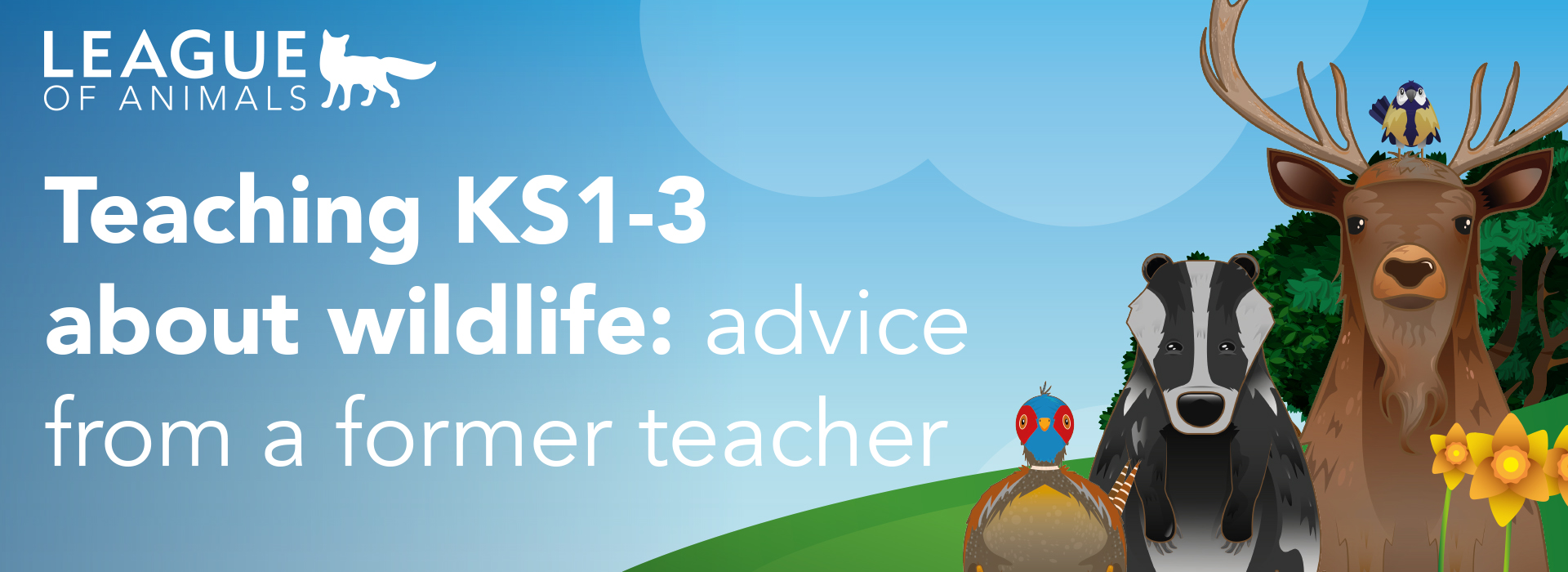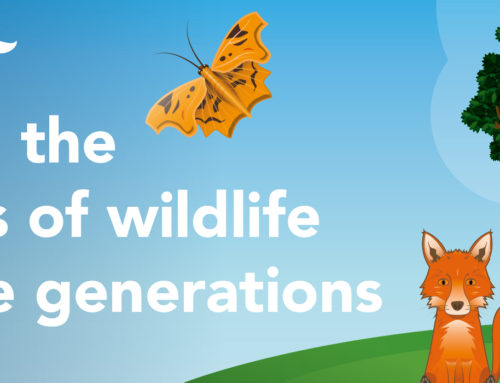As a child my interest in learning was sparked by nature.
From gazing at tigers leaping from the glossy pages of books and hoovering up facts about snakes that could eat me whole, to glimpsing deer in the garden of my grandparents’ house in the Lake District and chasing butterflies around the school playground.
This passion for learning led to me training to be a primary school teacher and then teaching at a school in my hometown of Birmingham. The burnout common to so many new teachers eventually caught up with me and I moved to pastures new, recently joining the League Against Cruel Sports to campaign on that issue which first fired me to learn: nature and working to protect it.
I was excited to learn about the League of Animals, a series of free educational resources for Key Stages 1-3 created to give teachers ready-made plans and materials to fire children’s passion for wildlife and the environment.
In the following I will explore my own experiences as a teacher of KS1 and KS2 children using wildlife and the environment both inside and outside of the classroom, and how the League of Animals’ new resources can help to inspire your class!

Re-wilding Your Class
Real life experiences of nature, however small, can really shape a child’s outlook on the world for the better.
A moment that I still think about frequently and has potentially had a huge impact on my life in terms of nurturing a passion for wildlife and working in environmental protection, came from a litter pick at school when I could only have been five or six years old.
I can still distinctly remember our teacher calling us over to see a discarded crisp packet where unfortunately a small insect had become trapped inside and drowned in the rainwater that had pooled inside it. Seeing the impact that human disregard has on the environment and other creatures right there in front of me and realising that I had a part I could play in preventing it, has stuck with me to this day.
Experiences such as this one lead me to believe that the best way to inspire a passion for wildlife is giving children that first-hand experience: getting out of the classroom to investigate and explore. While access to green open spaces on site is limited at urban schools such as the one that I taught at, nature always finds a way to creep into the greyest of environments and bring colour to the greyest of subjects.
When looking at recording data in maths for example, get outside! Gathering leaves from trees, bushes and weeds, as well as those blowing across the playground, allows children to sort, group and record what they have found in a variety of ways associated with arithmetic as well as allowing them to explore and learn from their surroundings.
This also provides a great opportunity to talk about our relationship with nature. Is it okay to pick leaves and flowers for no reason? What would happen if everyone did this? What would the impacts be on the plant? Which other living creatures could be affected? What do leaves do? The possible conversations are endless, as are the links to other areas of the curriculum.
Or how about, when educating children about the habitats that different animals live in, encouraging them to collect materials from outside to create homes for these creatures? What does the animal in question need and what about the properties of the materials you have found: are they waterproof, strong, malleable? And what writing can be drawn from the experience of building these homes? Can children create instructions on how to build their structure, or persuasively write about why an animal should choose to move into their building over their natural home?
These are ideas inspired by just two of the thirty lesson ideas included in the League of Animals’ resource packs, which also include ideas on how to link your lessons to further learning inside the curriculum as well as provoking wider conversations about our relationship with the natural world.
It is also important to remember that the benefits of taking learning outside are not limited to breathing life into other subjects and fostering an increased appreciation of the environment. Physically active learning can help to combat child obesity, improve the immune system, better motor skills, reduce symptoms of attention deficit hyperactivity disorder in children, and have positive after-effects on subsequent classroom learning across the curriculum!

Honey badgers in Birmingham?
Outdoor learning is not always possible though, and the idea of managing an excitable class outdoors on a blustery Friday afternoon in January is rarely the most appealing of options, but indoor lessons can be just as effective. The most engagement I had with my class around nature came from a chance conversation about honey badgers which, considering they are only found in the wild in Africa and Asia, you are unlikely to stumble across in a playground in Birmingham.
Each day when my class returned from lunchtime, they would be greeted by a different image on my interactive whiteboard to move their minds on from whatever playground politics had played out over the past hour. Sometimes it would be a photo of something tied into the afternoon activity, more often than not it would just be a cute animal photo as I found this often got the attention of my class. On one occasion I presented them with an image of a badger so I could tell them about an exciting run in I had had with a badger on my bicycle the night before, an unusual event in our urban setting.
Whilst only mildly interested in what I thought to be an exciting tale, what really piqued the class’s attention was another child’s unplanned and incredibly passionate monologue about what they had once read about honey badgers. The whole class were enthralled hearing about this formidable creature which was fearless in the face of lions, porcupines, buffaloes, and poisonous snakes despite its relatively small size. In a lesson on adaptation in the following weeks I pounced on this and used the honey badger’s numerous adaptations to its environment to demonstrate the subject.
A particularly memorable moment of the lesson came when I showed the class a map of where honey badgers live, to encourage them to start thinking about their habitat. As most of my class were of Pakistani origin, an audible gasp of terror spread through the class when they saw that honey badger is found in the country that they still had family in and often visited!

After reassuring them that honey badgers, despite their ferocity, were of no real danger to humans unless threatened, a fantastic lesson followed where children used the honey badgers’ adaptations to create their own made-up animals with weird and wonderful attributes suited the environments that they chose. It was not long before honey badgers snuck into imaginative stories in their writing too!
Despite the nearest wild honey badgers living almost 2,000 miles from our classroom in Birmingham, this wonderful animal captured my class’s attention, and as well as drawing out a great focal point for both science and creative writing, provided learning opportunities about our own interactions with nature when we discussed as a class how this dangerous animal would not harm a human unless threatened and how we must treat animals with care.
Using the League of Animals Resources
Like most in the profession, as a teacher I was continually short on time.
While I always aimed to make my own resources and lessons tailored to my class and differentiated for their varied abilities and needs, I would inevitably find myself at times browsing the internet for resources that would allow me to quickly create exciting activities, particularly for subjects other than Maths and English which too often are not given priority they deserve in schools.
Invariably I was underwhelmed with what was available online, often having to make large changes to resources to make them engaging; changes which often took just as long as creating my own from scratch!
It would have been beneficial to my practice if I had been aware of the League of Animals resources when I was teaching. Developed by teachers, for teachers, the resources available enable you to meet identified areas of the science national curriculum, whilst encouraging students to develop their curiosity of the natural world around them.
They also provide ideas and activities which can be drawn on in other subjects, with cross-curricular activities suggested as part of the resources, allowing you to gather the passion generated from engaging with wildlife and use it to inspire learners’ work across the school day.




Within the catalogue of League of Animals resources, you can find 30 different lesson plans for 60-, 30- and 10-minute sessions across a range of topics, perfect for both full lessons and filling short periods of time before an assembly or at the end of the day.
From scavenging in the playground or sitting in silence to appreciate nature, to leading discussions about the ethics of our relationships with animals, the online packs are a perfect and varied addition to any teacher’s bank of resources, beautifully illustrated and completely free!
Creating a kinder society
As teachers of young learners, creating a kinder world in general is something that we are all aiming for and the core values of the League of Animals closely reflect the values that we hope to inspire within those that we work with. Learning about wildlife can go a long way in helping to bring out these characteristics in our classes.
The natural compassion that we have as humans is rarely more evident than when animals are involved. This is frequently demonstrated by the huge public outcry that accompanies any stories about animal abuse that reach national news, such as the cruel killing of Cecil the lion at the hands of a US trophy hunter or the footage of Premier League footballer Kurt Zouma abusing his pet cat. Close contact between children and wildlife and understanding how our human world is interconnected with that of nature, can help to encourage this compassion and help young people extend it to other parts of their lives. Seeing how ants work together in a colony, or watching how long tailed tits care for each other, can serve as great lessons for children to understand the complexity of other beings, see how they have as much right to existence as us and garner compassion for the world accordingly.
Reversing the global trend of climate change and the decline in wildlife in the UK is going to take courage from today’s younger generation to be catalysts for change that will challenge this direction of travel. Forging a close connection between young people and their environment can only help to encourage this.
When children think about what animals need to survive, as the League of Animals’ resources on animal survival lead children to do, they come to understand how what we need to survive is shared. Ideas to help animals, such as walking and cycling more to reduce the pollution and road casualties, not throwing litter on the floor and preventing deforestation allow children to think about the big changes needed in the world to protect not just animals but ensure the survival of our entire planet.



